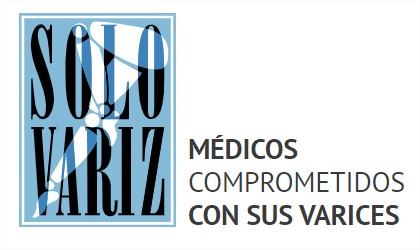What are
varicose veins?
Varicose veins are badly functioning veins
Blood circulation is basically a continuous movement of the blood through the vessels from the Heart, around the body and back to the Heart.
Veins and vessels spread similar to tree branches: the saphenous vein is the main trunk from which important branches grow. From them, spread the smaller branches that are the reticular veins and finally the leaves: the telangiectasias veins or vessels. This is why the importance of varicouse veins derives from their width.
In the healthy venous circulation of the legs, blood flows from the arterial capillaries, upwards, to the heart. This healthy circulation is carried out by a large number of veins, from which two main groups are distinguished:
Deep veins: close to the bone and very deep inside the leg. They conduct 95% of the blood in the legs. They don't produce varicose veins.
Superficial veins: they carry the blood from the skin towards the deep system. There are 4 main saphenous veins: 2 long ones (Internal Saphenous veins) and 2 short ones (external Saphenous veins).
There are also about 400 other veins of minor importance.
When these veins are altered and transformed into varicose veins, it is because circulation is going down towards the lowest part, the foot, generating the commonly known pathologies, both medical and aesthetical.
Why do they appear?
Nowadays, with the medical advances acquired, we can affirm that most of them have an hereditary origin.
They affect more women than men and studies affirm that one in every four people suffer from this pathology. We can say that a 40% to 60% of women will experience varicose veins and between a 15% and a 30% of men.
No obstante, existen muchos factores que pueden favorecer o acelerar la aparición de varices: sobrepeso, calor, largos períodos permaneciendo de pie a causa del trabajo, embarazos, y otros.
Varicose veins affect the patient progressively: they are not visible at an early stage but as years go by, blood tends to accumulate near the skin and becomes more and more visible with the risk of causing varicose bedsore.
Can they be prevented?
These are, briefly, a few ways to prevent this pathology:
Avoid:
- Standing for too long
- Little or no workout
- Exposing your legs to heat due to sun or working conditions
- For women, the use of the Pill and pregnancy
- The contraceptive pill and pregnancies favor the appearance of varicose veins in women.
Watch what you eat
Workout
Remember these are prevention methods. A patient already presenting varicose veins should not workout without the supervision of a Doctor.
Avoid inadecuate clothes and shoes
Extremely tight clothes or belts, when used frequently, can make it difficult for the blood to return up, therefore forcing the circulatory system and setting the ground for the appearance of varicose veins. The same thing happens when shoes are too tight, too high or too flat.
Relieving the sympthoms caused by varicose veins:
- Use compression tights
- Put your legs up high and apply a massage from the ankle to the knees
- Avoid standing up or crossing your legs for too long
- Sleep with your feet slightly elevated
- Avoid wearing very high heels or flat shoes, and tight clothes
- Avoid wearing very high heels or flat shoes, and tight clothes
- Eleva las piernas al mediodía durante media hora, aproximadamente

